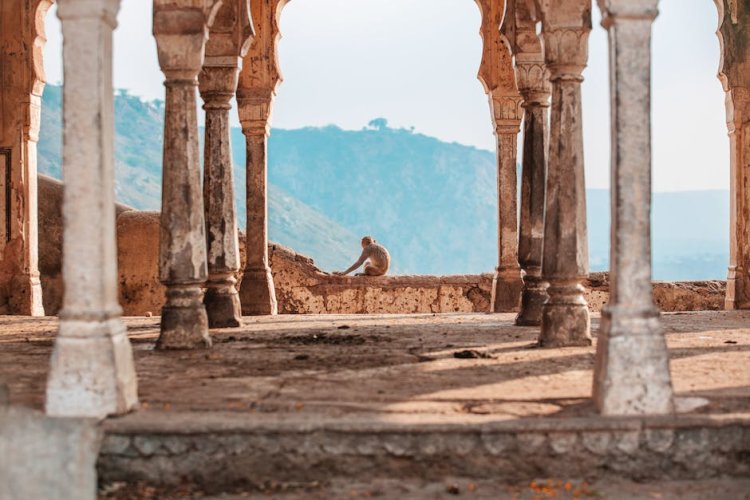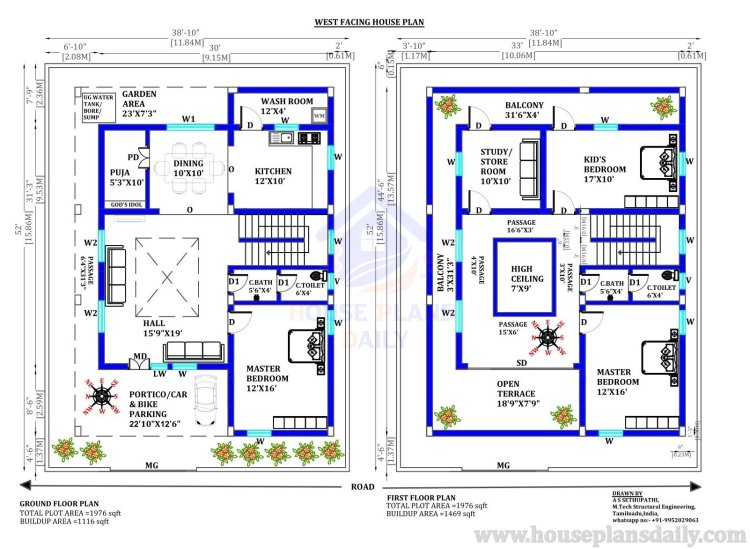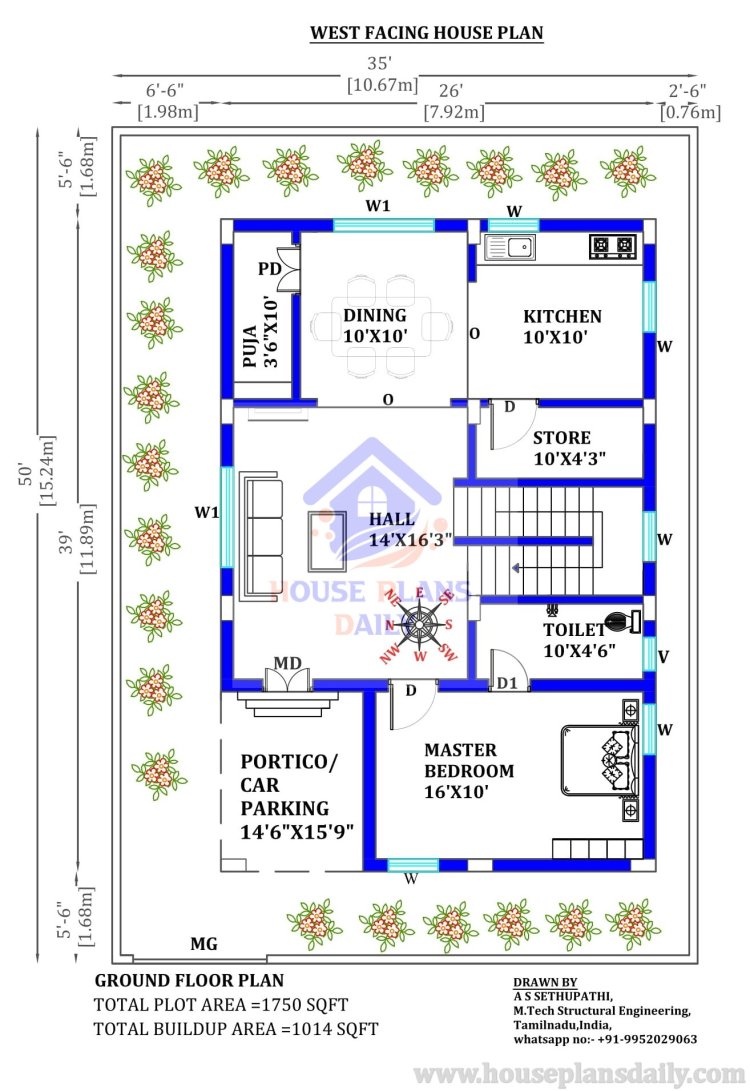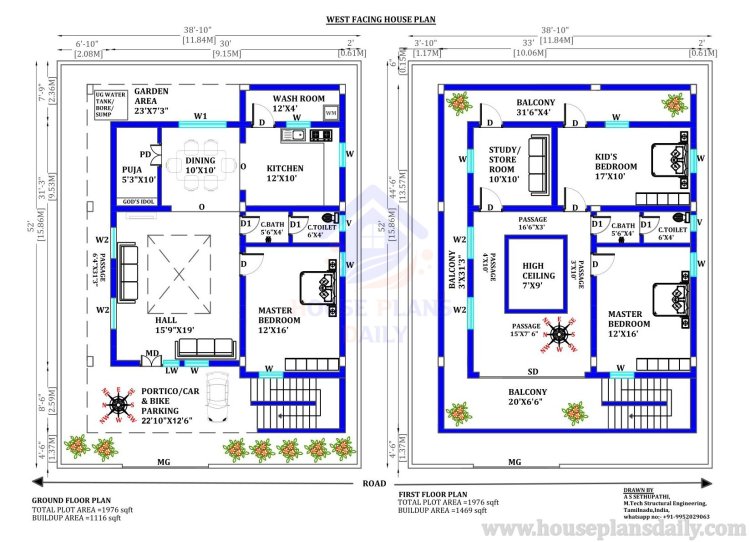Vastu House Plan West Facing | Vastu Plans | Vastu Homes
Vastu Shastra, a primeval Indian system of architecture, has held the attention of architects and homebuilders for centuries, and continues to do so with its unique principles of order and alignment.
Vastu House Plan West Facing | Vastu Plans | Vastu Homes
Vastu Shastra, a primeval Indian system of architecture, has held the attention of architects and homebuilders for centuries, and continues to do so with its unique principles of order and alignment. Its components, which form a grounded harmony between man and nature, have influenced residential design approaches globally. This essay delves into the intriguing world of Vastu Shastra, placing emphasis on the design and layout of West facing homes - an aspect often ensnared by myths and misconceptions. With a meticulously crafted blend of theoretical insights and practical implementations, it seeks to enlighten readers on the benefits and architectural strategies pertinent to a West facing home built on the foundation of Vastu principles.

west vastu plan
Understanding Vastu Shastra
The Scientific Basis of Vastu Shastra and Its Impact on Architecture
The beauty and depth of architecture extend beyond aesthetics and functionality and for centuries played a reflective role in a society’s belief and cultural systems. A prime example of this intersection of cultural belief systems and architectural design is found within the ancient Indian discipline of Vastu Shastra.
Vastu Shastra, dating back to more than 5,000 years ago, prescribes the optimal design and direction of buildings to harness impressively the energy of the cosmos. Beyond its spiritual significance, Vastu Shastra also surprisingly showcases a profound grasp of architectural science and principles, both in building design and construction.
Similar to other ancient architectural treatises worldwide, Vastu Shastra incorporates an environmental perspective, endorsing the orientation of the building design around natural elements. It emphasizes the role of the Sun, direction of wind, and magnetic fields in creating an equilibrium of energy within a building.
The principle of aligning homes to cardinal directions is derived from an acute understanding of the Sun's trajectory. Such alignment allows the optimization of daylight, resulting in thermal comfort, energy-saving, and enhancement of occupants' well-being. This is a commendable example of passive solar design, long before the term came into existence, thus, attesting to the scientific validity of Vastu Shastra.
Geomagnetic forces, another focal point in Vastu Shastra, have shown potential health implications in numerous contemporary scientific researches. Vastu Shastra's emphasis on geomagnetic alignment in its design principles could thus be seen as a pragmatic approach to preventing any adverse effects from these forces.
Moreover, architectural physics plays a central part in the understanding of Vastu Shastra. One such principle promotes height increment from east to west in construction design, preventing long shadows from forming, ensuring homes are free from damp soil, avoiding the blocking of the Sun’s rays, and helping air circulate more freely.
Of noteworthy mention is Vastu Shastra’s anticipation to ensure resilience against climatic and environmental disasters during a building's construction. The adoption of locally available materials - an early nod towards sustainable practices – is also recommended within this ancient discipline.
Vastu Shastra, indeed, showcases a symbiotic relationship between belief-driven architectural design and deeply rooted scientific understanding. Its principles, often seen as prescriptive and steeped in spirituality, reveal profound logic and environmental insights. The discipline offers noteworthy insights in effectively harnessing natural elements to create harmonious, energy-efficient, and resilient buildings.
The integration of Vastu Shastra's principles in contemporary architecture can lead to culturally relevant, sustainable designs that honor millennia-old wisdom while addressing the demands of modern living. This blend of ancient wisdom and scientific logic grants Vastu Shastra a worthy place in today’s deliberations on architecture and design. Embracing Vastu Shastra is not only a nod to traditional practices but also the introduction of an environmental, sustainable and health-focused perspective in modern architecture.

vastu ideas
West Facing Home: Benefits and Misconceptions
Shifting Focus to West Facing Homes - Misunderstandings and Benefits
Upon delving into the realm of Vastu Shastra, one encounters a plethora of misunderstanding and misconceptions, especially regarding the orientation of homes. West facing homes are subjected to a ceaseless stream of skepticism due to conditioning by age-old prejudices and misunderstandings. However, an objective scientific perspective offers a refreshing perspective, dispelling fallacies and promising potential benefits.
Common misconceptions about West facing homes are primarily rooted in cultural and religious notions, with Vastu Shastra mystified to the point of misrepresentation. The prevailing myth suggests that homes facing west invite nefariousness and negative energy, leading to financial hardships and bad luck. Scientifically, these notions are largely unsubstantiated and are instead influenced by the psychological bias of pre-existing belief systems.
Busting the myth: Substantiated by scientific principles, West facing homes can be as auspicious and beneficial as homes with other orientations. Solar physics conveniently serves as an explanation. As the Sun transits from the east to the west, West facing houses utilise the afternoon sun, a pivotal factor in colder climates. The west orientation can assist in capturing the warmth of the afternoon and evening sun, creating naturally warmer homes, connotatively meshing with the principles of passive solar design.
Moreover, taking into account Intertropical Convergence Zone (ITCZ) shifts, a West placing advantage can be observed in terms of wind patterns in tropical and subtropical climates, where trade winds predominantly flow from east to west. The west-facing openings of homes can therefore gain from these natural ventilation prospects, contributing to healthier and more comfortable living environments.
Furthermore, this west orientation doesn't only align with the environmental aspect. Reflecting on the circadian rhythm – natural, internal processes that regulate the sleep-wake cycle - it could be inferred that the exposure to the evening sunlight may benefit the cycle by potentially promoting evening alertness.
From an urban planning perspective, west facing homes can also be beneficial. Given the proper planning, the layout of the city can be designed to prevent the sun’s glare from affecting drivers during peak traffic hours in the morning, increasing overall safety in the city.
In summary, interpretations of Vastu Shastra and their application toward architectural design need to be seen through the lens of science. While respecting the historical and cultural relevance, it is critical to not overlook the empirical possibilities. It becomes evident that misconceptions regarding West facing homes are largely steeped in unexamined traditions rather than scientific facts. When seen from the perspective of environmental architecture, urban city planning, and circadian rhythm synchronization, West facing homes not only debunk the myths fashioned against them but also reveal their potentiality, ultimately influencing modern architectural principles in a significant manner.
It's high time we reconceptualize our understandings of Vastu Shastra, unwrapping it from the shroud of myths and speculative beliefs, and start aligning it with perspective grounded in rationality, pragmatism, and science.

vastu tips
Crafting the Ideal West Facing Vastu House Plan
As we delve further into the application of Vastu principles to West-facing homes, it comes to light that there are several pivotal elements in play. To apply Vastu principles toward architectural design, one must meticulously consider certain factors that go beyond the simplistic notions of orientation and placement. These factors, in order of importance, include the allotment of spaces, the flow of energy, and the arrangement of objects in the indoor space.
In Vastu Shastra, the division of spaces is of paramount importance. It’s not just about where the building faces, it’s about careful division and utilization of space within the building. An effective Vastu-compliant design allocates functional areas of a home based on energies attributed to cardinal directions. For a West-facing house, the placement of the main door holds vital importance. Traditionally, the South-West portion of the house is considered auspicious for the main entrance as it's believed to invite wealth and prosperity.
Next, the principle of energy flow plays a significant role in determining the Vastu compliance of a structure. Known as “Pran” within Vastu Shastra, this life-force energy must flow smoothly. Pran flows from North to South, and East to West due to Earth's magnetic fields. To facilitate this, functional spaces in West-facing homes should be aligned as per Vastu principles. It's advisable to locate the kitchen in the South-East for the optimum benefits of morning sunlight, while bedrooms should be in the South or South-West for restful sleep.
Finally, the arrangement of objects within these spaces also contribute to the harmony of the dwelling. The placement of furniture, decor, and even appliances should follow a certain structure, not only for aesthetic coherence but also for the unimpeded flow of Pran. This element, though often disregarded, as trivial, carries vital significance in Vastu Shastra.
In discussing Vastu-compliant West-facing homes, it’s crucial that the conversation doesn't end at the level of debunking misconceptions or merely understanding the benefits. It's essential to comprehend and internalize that every facet of the architectural structure, every space within it, and every object placed within these spaces have their role to play in optimizing positive energy flows. Vastu Shastra, in its essence, offers a comprehensive guide to building harmony within the dwelling space, aligning the residents with the rhythms of the natural world around them.

west facing house plans design
Implementing Vastu Tips for Enhancing Positive Energy
Vastu Shastra doesn't merely dictate the broad architectural arrangements but percolates to the minutiae of spatial configurations. It vehemently emphasizes the correct division of space, which facilitates an uninterrupted flow of positive energy. A usual misconception regarding West-facing homes is the inopportune placement of the main door; however, as per Vastu principles, the placement plays a critical role in harnessing positivity. The doorway in a West-facing house should ideally be located in the north-west direction, allowing beneficial rays of the setting sun to permeate the dwelling, fostering good health and prosperity.
One of the cornerstone principles of Vastu Shastra is the concept of Prana (energy flow). The idea is premised on the concept that fixing elemental imbalances could restore the flow of energy. Vastu nudges this understanding further by detailing how one could optimize the placement of architectural components and interior objects to benefit from a positive energy flow. Therefore, engaging with Vastu necessitates a nuanced understanding of the nature of the architectural structure at hand.
Applying Vastu Shastra to the arrangement of rooms in a West-facing home often follows the same principles guiding all Vastu-compliant homes. For instance, the recommended location for kitchens is the southeast section of the house, aligning with the fire element. Bedrooms placed in the southwest promote stability and tranquillity while adhering to Vastu norms.
Moreover, the orientation and placement of objects within these spaces carry equal importance. Objects arranged in correspondence with their associated directions, as specified by Vastu, can channelize positive energy, elevating the overall positivity within the house. A classic illustration of this is the placement of the kitchen stove, preferably in the southeast corner, ensuring that the cook faces east while cooking, aligning with the elemental association of the element fire.
In conclusion, Vastu Shastra's core tenet propounds a holistic approach to architecture and spatial design, aiming for prosperity and happiness. A west-facing home's arrangement, combining empirical understanding with resilient traditional knowledge, reflects complex dynamics between human life and the natural environment, making Vastu Shastra a profound guide for creating harmonious living spaces.


Case Studies and In-depth Analysis
By assimilating the principles of Vastu Shastra, architects and designers create West-facing house plans that have not only reaffirmed the holistic utility and significance of this ancient science but also contributed to its renewed popularity.
The tangible differences witnessed are remarkable, and this article elucidates these unique elements brought by Vastu Shastra in designing West-facing homes.
In order to placate cultural and religious misconceptions surrounding West-facing homes, architects employing Vastu Shastra consider the house's space division. It is an essential element that dictates the harmonious distribution of energies within the dwelling.
According to Vastu principles, dividing the space in such a manner results in an optimized channelization of positive energies, thereby nullifying any baseless negative connotations associated with West-facing homes.
Moreover, the main door placement in a West-facing house is instrumental in substantiating the principles of Vastu Shastra. The western direction is deemed a direction of gains and prosperity, and placing the main door in certain favorable 'padas' or steps is said to attract positive energies. This consideration affirms the significance such details hold in Vastu Shastra, encapsulating its practicality for modern architectural designs.
The principle of Prana, or the energy flow, is a central tenet in Vastu Shastra. Architects proficient in this science set their buildings' spaces where the household's activities will strengthen this flow, further enhancing the dweller's comfort and well-being.
In a West-facing house, the kitchen - a place of fire - and bedrooms must be positioned prudently to ensure maximum benefits from natural energies.
Vastu Shastra's prescriptions extend beyond just architectural designs; they encompass arrangements within the structure - like furniture placement and the orientation of varying objects. Ensuring that all these details align with the stipulations of Vastu Shastra can result in an augmented positive energy balance within the house, fostering prosperity and peace.
Finally, as experts continually reimagine architectural designs, Vastu Shastra principles remain pivotal in shaping this field. By guiding the placement and orientation of varying parts and spaces within a West-facing house, these immutable principles, created centuries ago, assist in creating harmonious homes for contemporary dwellers.
Its usage in bedroom and kitchen placements, door orientation, and space division reinforces its relevance and its predominant role in architecture and design today.
From the application of the Prana principle to strategizing the placements of rooms, main doors, and objects, Vastu Shastra's tenets continue to validated substantively in architectural terms. Their application in West-facing homes yields a tangibly harmonious environment, dispelling age-old misconceptions and embracing a holistic, beneficial system of architectural planning and design.
Adjusting building plans to these age-old principles thus remains more than just culture-conservation; indeed, it is an architectural exercise in enhancing prosperity, harmony, and well-being for the dwellers.

west facing vastu plan
All the elements of a residential structure hold subtle significance in the grand scheme of Vastu Shastra. The ancient wisdom it leans on provides an insightful framework for mapping and designing homes, especially those facing west. By debunking prevailing misconceptions and strategically applying the tenets of this age-old science, one can create a space that not only aligns with intellect and aesthetics but also vibrates with positive energy. This detailed exploration of Vastu Shastra for West facing houses underscores the seamless marriage between tradition and modernity, illustrating the enduring relevance of Vastu principles in contemporary architecture.


















